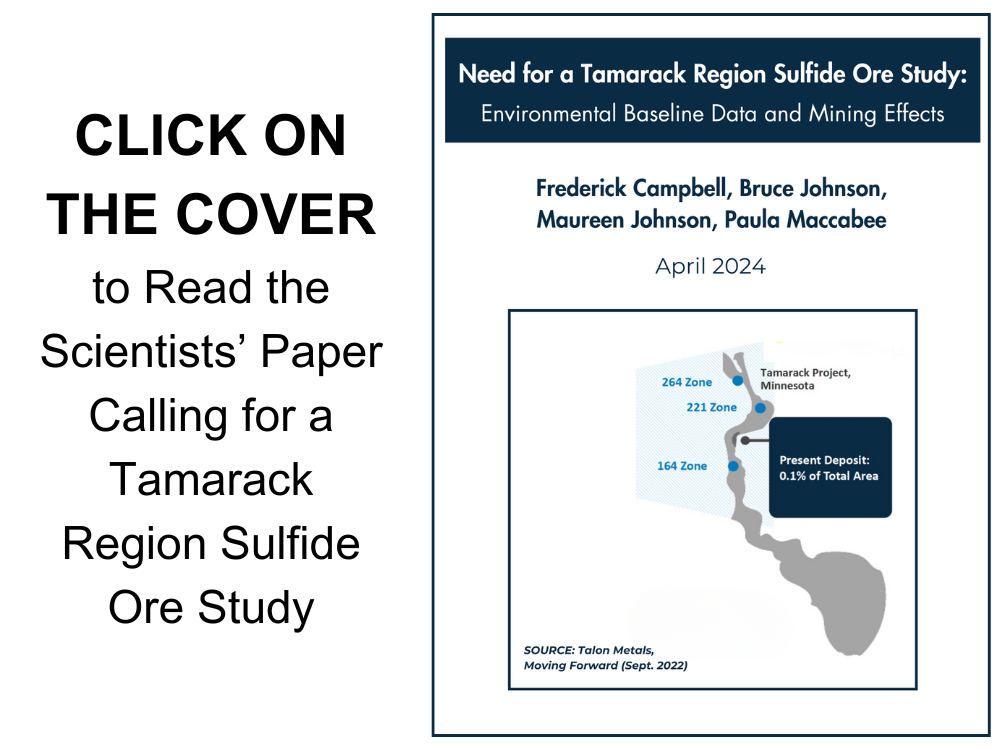Talon Metals/Rio Tinto Tamarack Nickel Sulfide Ore Mine
Threats to the Mississippi and St. Croix River Watersheds
Talon Metals/Rio Tinto plans to mine a “massive sulphide mineralization” with high levels of sulfide and toxic metals. Drilling in the huge 31,000 acre area where Talon controls private land and state leases (about 85% of the size of Minneapolis) controlled by Talon Metals in central Minnesota’s Aitkin County, Talon has already found sulfide ore both in the Sandy River and Tamarack River watershed, which flow through the Big Sandy Lake Flowage to the Mississippi River and along the West Branch Kettle River, which flows downstream to the St. Croix River.

Talon Mine Site Wetlands, Waters, and Wild Rice
The map below, prepared by St. Croix 360, shows the mineral lease area secured by Rio Tinto and Talon Metals, along with drilling sites, and some of the major water features in the area that would be affected by a Talon Nickel Mine.

Minnesota agency scientists who worked on the Duluth Complex area Copper-Nickel Regional Study in the 1970s are now calling for a similar Tamarack Region Sulfide Ore Study of environmental baseline data and mining effects before any site-specific Talon Metals or Rio Tinto mine is considered.
No prior Minnesota study has evaluated the Tamarack Intrusive Complex or the effects of sulfide ore mining upstream of the St. Croix and Mississippi River watersheds and Minnesota’s largest population center, the Twin Cities. Talon has told investors that the “present” deposit proposed for environmental review is one-tenth of 1% of the total district-scale mining area.
SIGN OUR PETITION FOR THE “WHOLE TRUTH”
Full Disclosure in Talon Metals Environmental Review
The entire proposed mine area is primarily wetlands and peatlands. Round Lake is a rare tullibee lake vital to preserve cold water fish in a time of climate change, and Lake Minnewawa, Big Sandy Lake, and many nearby lakes, rivers, and streams are wild rice waters. Wild rice (manoomin) is the sacred grain of the Anishinaabe people, vital to tribal culture, nutrition, and economic well-being.
As measured by the number of harvesting trips, Aitkin County, where the Talon nickel mine would be located, is an area of great wild rice abundance. Sulfate pollution from sulfide mining decimates wild rice. In addition, mine dewatering harms the hydrology needed to sustain wild rice and wetlands ecosystems and the quality of recreation and fishing lakes.
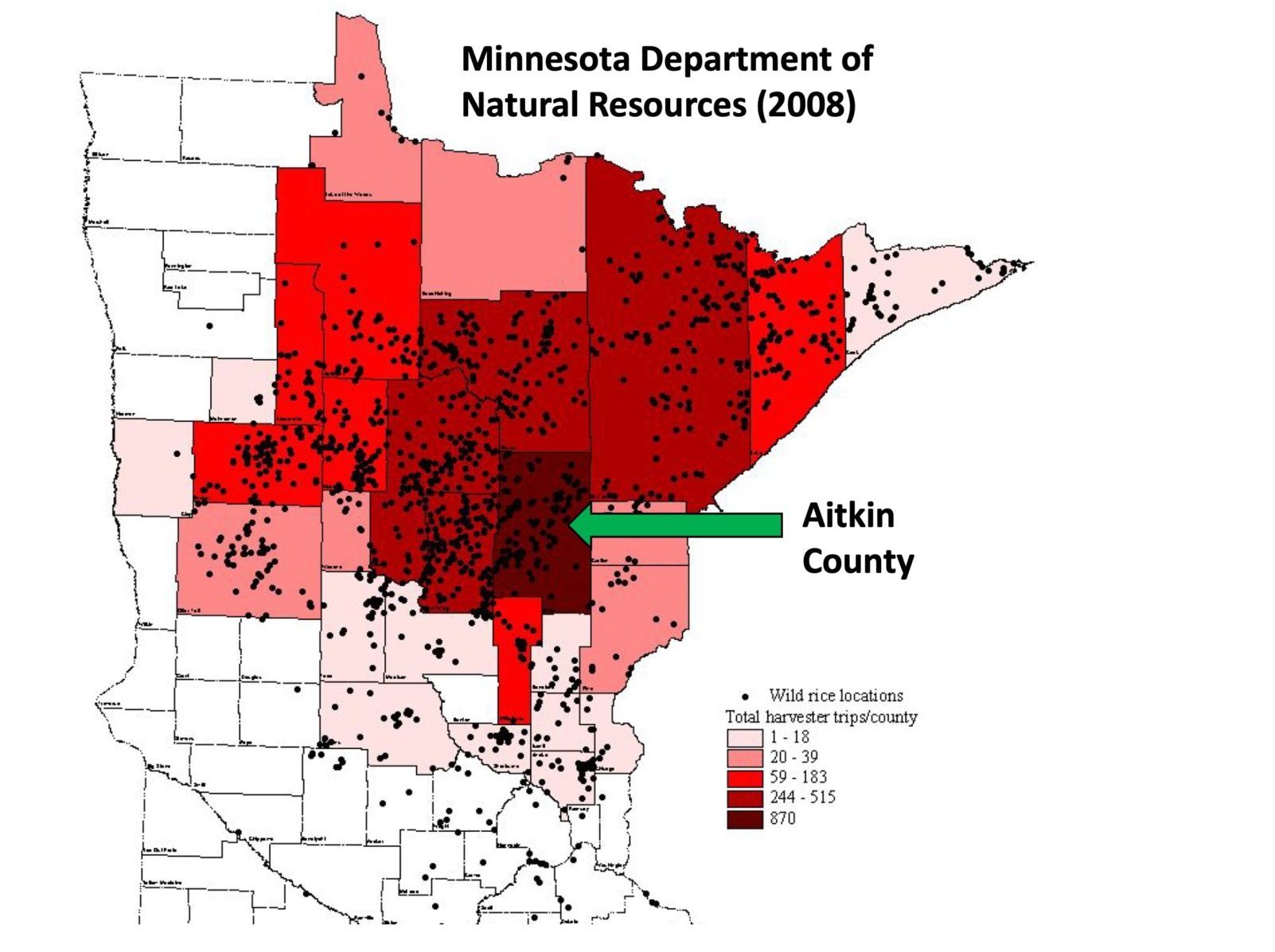
The Salo Marsh State Wildlife Management Area and the West Branch of the Kettle River are located in areas where Talon has actively drilled for sulfide metals. Both the Kettle River and the St. Croix Rivers, which would be impacted by mining the southern part of the Tamarack Mineral Intrusion, are Wild and Scenic Rivers. The McGregor Marsh Scientific and Natural Area and the Rice Lake National Wildlife Refuge are southwest of the mineral deposit.
Both the Tamarack River and the Sandy River flow into Big Sandy Lake and through the Sandy Lake Flowage into the Mississippi River. Sandy Lake was the site of an estimated 400 deaths in 1850-1851, when the U. S. Government attempted to relocate Indigenous people and failed to make Treaty payments, causing many people to starve. The history of pressure to relocate the Ojibwe/Chippewa is closely bound up with mining. Read more about the Sandy Lake Tragedy and Memorial and watch a video of the Memorial, They Are Remembered: Sandy Lake.
Talon Nickel Sulfide Ore Mine Pollution Threat
No sulfide mine has operated in a water-rich environment without contaminating surface and/or groundwater with acid mine drainage, toxic metals, or both. Big Sandy Lake and Lake Minnewawa are already impaired due to excessive nutrients and toxic mercury. Round Lake, the Kettle River and the St. Croix River are already impaired due to excessive toxic mercury in fish.
Sulfate pollution from mining would increase excessive nutrients that cause algae blooms and toxic mercury contamination of fish. Sulfate may double the release of phosphorus, nitrogen, and mercury from sediments and the formation of methylmercury six-fold. Methylmercury is the type of mercury that bioaccumulates in the food chain and harms wildlife and humans who eat methylmercury-contaminated fish.
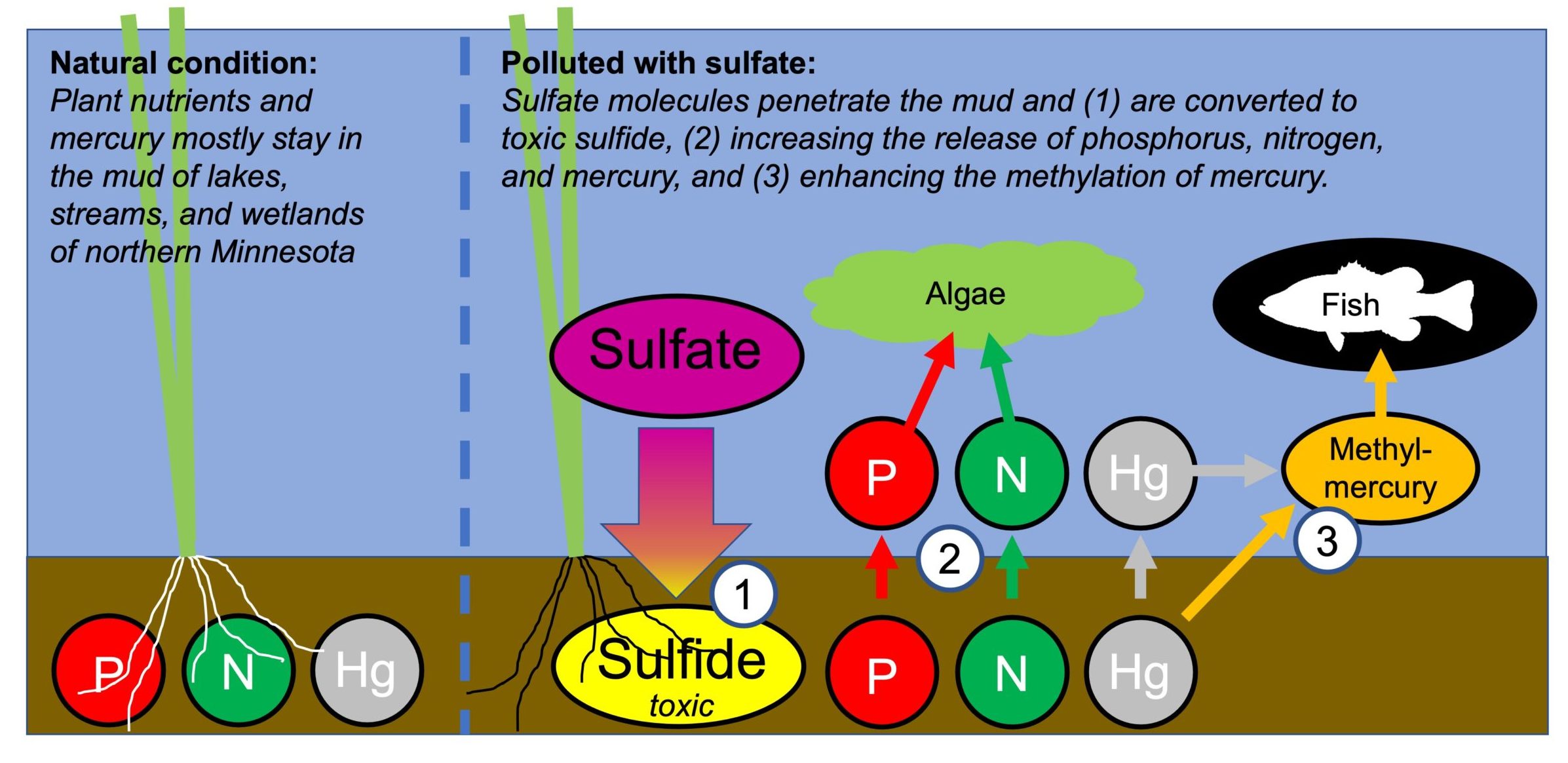
Schematic prepared by Amy Myrbo, PhD, working with Friends of the Boundary Waters and with WaterLegacy
Affected Local and Downstream Communities
The region where the Talon mine has been proposed is a predominantly low-income rural community that includes Reservation and Ceded Territory lands and waters of the Mille Lacs Band of Ojibwe and East Lake and Minnewawa Communities; Sandy Lake Band of Mississippi Chippewa; Leech Lake Band of Ojibwe; White Earth Nation; and the Fond du Lac, Grand Portage, and Bois Forte Bands of Lake Superior Chippewa. The 1854 and 1855 Treaties reserved tribal rights to hunt, fish, and gather plants, including wild rice.
The effects of sulfide ore pollution and mercury contamination of fish also harm people who drink water and catch fish from downstream rivers, including the St. Croix and Mississippi Rivers. Fetuses, infants and children are particularly vulnerable to the neurotoxic effect of mercury on their developing brains when they or their mothers eat mercury-contaminated fish. Low income, minority, and tribal communities who rely on fish for subsistence bear a disproportionate burden if fish are contaminated with mercury.
In addition to effects on wild rice, nickel sulfide ore mining creates health risks from air emissions (crushing, loading, hauling) of ore and waste rock. Nickel dust is a carcinogen that causes lung cancer, and mining particulates can also cause lung and heart disease.
Nitrates used in ammonium nitrate explosives to blast ore from the ground impair the way in which blood carries oxygen and nitrates in drinking water can be fatal to infants. Arsenic can be leached from the host rock into drinking water; it is a Group 1 carcinogen that targets multiple organ systems. The Eagle Mine, often cited as a “model” for the Talon nickel mine, has resulted in exceedances of the U.S. Environmental Protection Agency drinking water standards for both nitrates and arsenic.
Talon Metals Mineral Deposit and Mine Proposal
As suggested by the scope of mineral leases secured by Rio Tinto and Talon Metals over the past two decades, the sulfide ore mineral deposit, what Talon calls the “Tamarack Intrusive Complex,” is large and much of the deposit is located south of Highway 210, affecting the Kettle River and St. Croix River watersheds as well as the Mississippi River downstream.
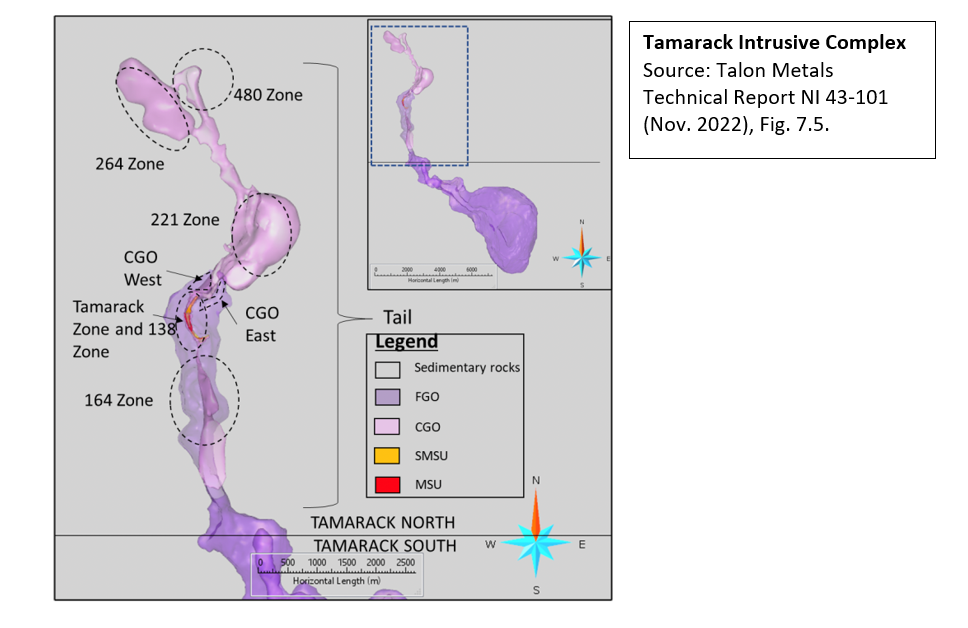
In fact, Talon Metals has proclaimed in the news media that its mine has “district-scale potential.”
“[T]he Tamarack Intrusive Complex has district-scale potential.”
– Talon chief exploration and operations officer Brian Goldner (Jan. 2023)
Source: Talon Metals January 2023
Talon Metals Environmental Review Process
Talon Metals began the environmental review and permitting process by submitting a proposed Environmental Assessment Worksheet to the Minnesota Department of Natural Resources (DNR) on June 21, 2023. The Minnesota DNR is the “responsible governmental unit” for environmental review, and both the Minnesota DNR and the Minnesota Pollution Control Agency (MPCA) issue permits for sulfide mine projects. As compared to the “Tamarack Intrusive Complex” known sulfide ore deposit, the “project” that Talon submitted for environmental review is quite small.
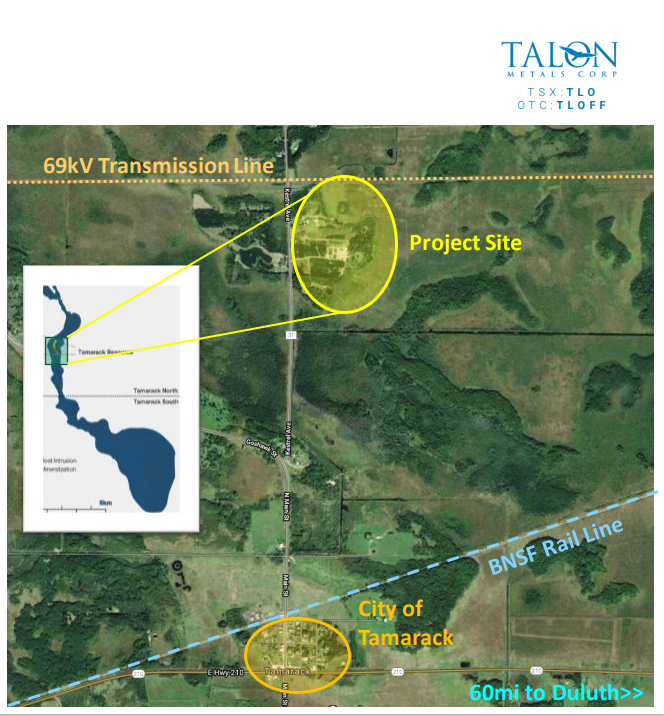
Source: Talon Metals Slide Deck, Jan. 2023.
Talon has admitted that its goal is to conduct a limited environmental review, get a permit, and then continue to expand the mine to achieve its “district scale potential.”
“[W]e can push forward this mine in the permitting process and hopefully get a permit while we’re also exploring for additional nickel resources in Minnesota.”
– Talon chief external affairs officer Todd Malan (June 2023)
Environmental Review will, at a minimum, contain the following steps:
- Mandatory Environmental Impact Statement (EIS) for new mine. Minn. R. 4410.4400, subp. 8(B).
- The Minnesota DNR will review Talon Metals’ submittal to assess whether the basic information is present for scoping what must be in EIS.
- DNR and Cooperating Agencies will prepare a draft scoping EAW and proposed EIS scoping decision. There is no time limit for this step of the process.
- There will be at least one public scoping meeting and an opportunity for public written comments on the scope of the EIS. The minimum time for public comment on scoping is 30 days.
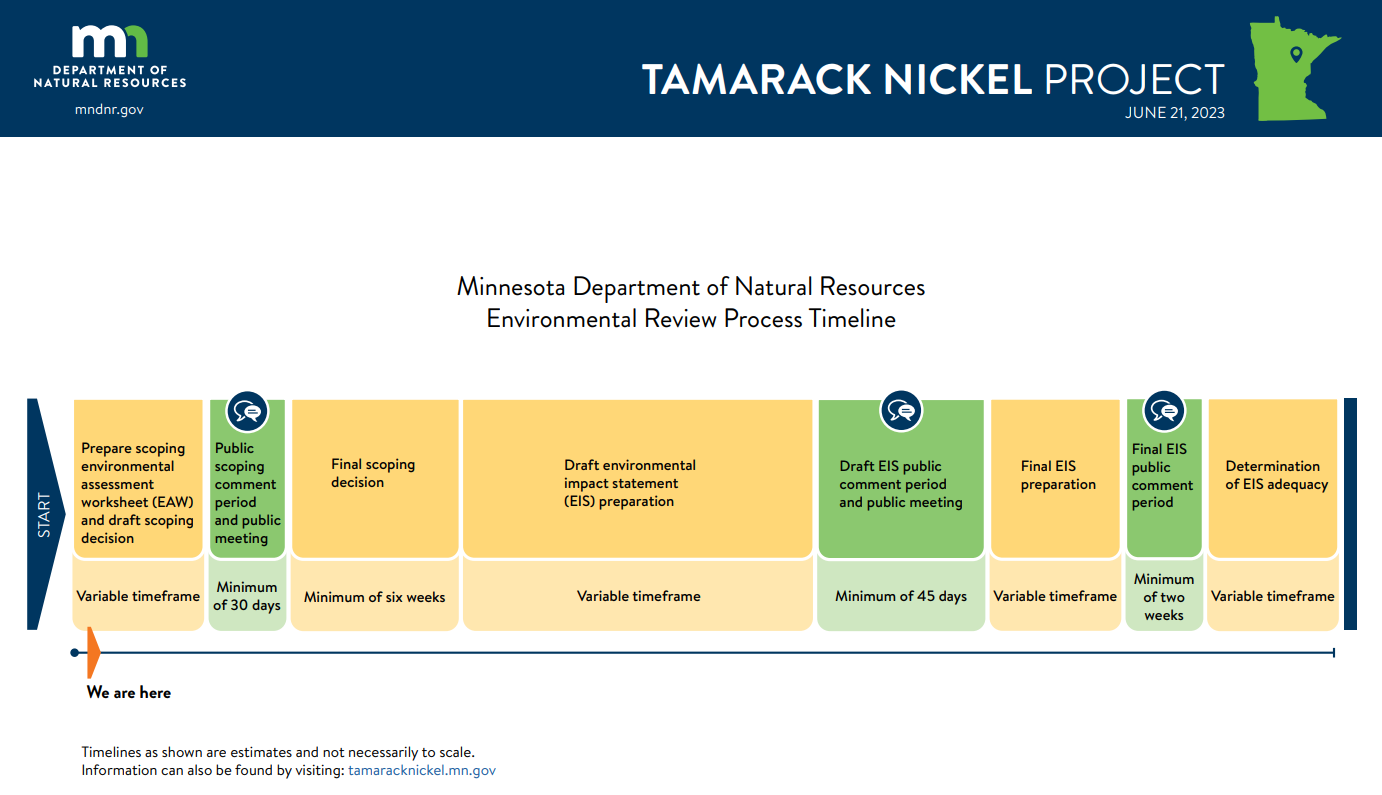
Premature and Questionable Mine Subsidy
In October 2022, even before the Talon Metals Tamarack mine was formally proposed, the Biden Administration granted nearly $115 million to Talon Metals to build a plant in North Dakota to process nickel sulfide ore from the Tamarack, Minnesota area Talon line. The Talon mine had undergone no environmental study and received no permits. The company has conducted no consultation with affected Indigenous communities, obtained no tribal consent, and provided no information to the community on impacts to local or downstream waters.
On August 15, 2023, WaterLegacy, Honor the Earth, Earthworks and a total of 80 environmental, civic, and faith groups sent a letter to President Biden, the U.S. Department of Energy, the U.S. Department of the Interior, and the U.S. Environmental Protection Agency opposing the Administration’s premature commitment of $114,846,344 to the Talon Metals mine. This letter called upon the Biden Administration to take the following actions:
-
Commit to release no subsidy funds for Talon Metals unless and until environmental review, tribal consultation, and permitting are completed and tribal consent secured.
-
Prepare a federal environmental impact statement analyzing harm from the entire Tamarack mineral body.
-
Consider tribal treaty-reserved rights, wetlands, and ecosystem values in determining whether the water resources may not be harmed under the Clean Water Act.
-
Grant funds to the U.S. Geological Survey in collaboration with tribes and the EPA to study hydrology and potential impacts of mining and mine dewatering on groundwater, surface water, and wetlands.
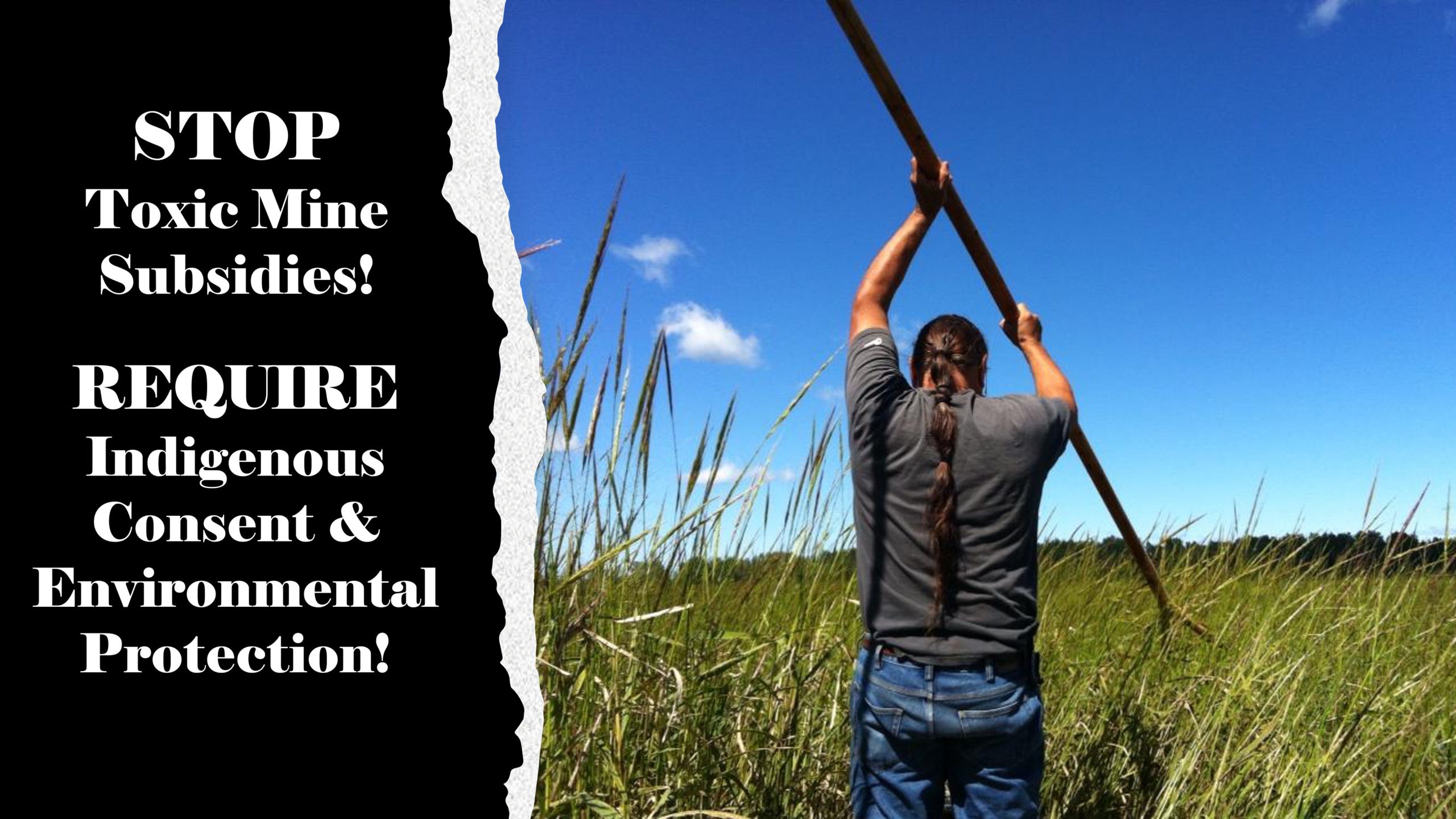
On October 5, 2023, WaterLegacy, Honor the Earth, and the Sierra Club North Star Chapter sent 7,157 petition signatures to Department of Energy (DOE) Secretary Granholm asking the DOE:
Please withhold the $115 million DOE subsidy for Talon Metals/Rio Tinto nickel-copper-cobalt sulfide ore mine processing unless and until comprehensive federal and state environmental review, tribal consultation, and permitting are completed for the mine project and Indigenous consent secured. Support federal funding for in-depth U.S.G.S. and tribal study of hydrology and impacts of Talon mine pollution and dewatering before environmental review is completed.
Additional Resources
FACT SHEET
Download and share WaterLegacy’s updated Fact Sheet on the Tamarack Sulfide Mine Threat.
SLIDE PRESENTATIONS:
Protecting Minnesota Waters: Science, Law and Community Action (Paula Maccabee, January 2024)
DNR WEBSITE WITH ENVIRONMENTAL REVIEW UPDATES
Tamarack Mining Project Environmental Impact Statement
TALON METALS REFERENCE DOCUMENTS
Talon Metals Preliminary Economic Assessment – NI 43-101 (Jan. 8, 2021)
Describes profitability, which is not dependent on use of nickel for electric vehicles (see page 332).
Talon Metals Technical Report Tamarack North (Mineral Resource) – NI 43-101 (Nov. 2, 2022)
Shows entire Tamarack Mineral Intrusion, but only describes the mineral resource of the “North” mine project. Contains limited environmental information as well.
Talon Metals’ Nickel Tamarack Mining Project Environmental Assessment Worksheet (June 21, 2023)
Proposes very limited scope initial mining project. Initiates environmental review process.
COMMENTARIES:
MinnPost Commentary: The whole truth about Talon Metals and Rio Tinto (April 16, 2024)
“Sulfide ore mining threatens the clean water and natural resources future generations will rely on for health, culture and their very survival. It is time for Minnesota to require that mining companies Talon Metals and Rio Tinto tell the whole truth about the dangers and scale of their proposed Tamarack nickel-cobalt-copper mine here in Minnesota. That would require a new regional study.”
Star Tribune Commentary: Beware “limited scope” Talon Metals Nickel Project (July 11, 2023)
“The “whole camel” entering the tent with Talon Metals will include a huge mineral excavation and likely on-site processing, tailings and waste rock storage. It may also include a smelter not just for Talon, but to satisfy the market for smelting concentrates from half a dozen other nearby copper-nickel projects waiting for approval. Does Minnesota want this foreign beast in our state?”
Local View: Proposed Tamarack mine poses familiar environmental risks
“Talon is proposing to mine a ‘massive sulphide mineralization’ at the headwaters of the Big Sandy Lake watershed, an hour southwest of Duluth. This watershed enjoys clean water and fresh air, abundant wild rice protected by treaty-reserved rights, treasured lake retreats, forests, and wildlife. It is a hunter’s and angler’s paradise.”

